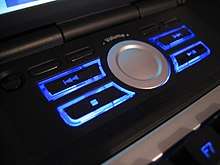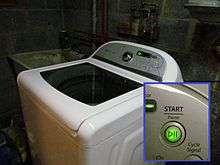Media control symbols
In digital electronics, analogue electronics and entertainment, the user interface of media may include media controls or player controls, to enact and change or adjust the process of watching film or listening to audio. These widely known symbols can be found in a multitude of software products, exemplifying what is known as dominant design.
Symbols

These are common icons on physical devices and application software. They are commonly found on portable media players, VCRs, DVD players, record players, remote controls, tape players and multimedia keyboards. Their application is described in ISO/IEC 18035[1].
The main symbols date back to the 1960s, with the Pause symbol having reportedly been invented at Ampex during that decade for use on reel-to-reel audio recorder controls, due to the difficulty of translating the word "pause" into some languages used in foreign markets. The Pause symbol was designed as a variation on the existing square Stop symbol and was intended to evoke the concept of an interruption or "stutter stop".[2][3]
| Symbol | Unicode | Name / function | ISO 7000 / IEC 60417 | |
|---|---|---|---|---|
| U+23F5 ⏵, U+25B6 ▶/▶️ | Play | #5107B Normal run; Normal speed | "To identify the switch or switch position by means of which a normal run (e.g. of tape) is started in the indicated direction." | |
| U+23F8 ⏸/⏸️ | Pause | #5111B Pause; Interruption | "To identify the control or the indicator which stops operation intermittently and keeps the equipment in operating mode" | |
| U+23EF ⏯/⏯️ | Play/Pause toggle | — | ||
| U+23F4 ⏴, U+25C0 ◀/◀️ | Reverse | — | ||
| U+23F9 ⏹/⏹️ | Stop | #5110B Stop | "To identify the control or the indicator to stop the active function." | |
| U+23EA ⏪/⏪️ | Rewind (Fast Backwards) | — | ||
| U+23E9 ⏩/⏩️ | Fast forward | #5108B Fast run; fast speed | "To identify the switch or switch position by which a faster than normal run (e.g. of tape) is started in the indicated direction." | |
| U+23EE ⏮/⏮️ | Skip to the start or previous file/track/chapter | (#5862 Previous; to play previous part) | "To identify the control or the indicator to skip back to the top of the previous section, play the section and then stop." | |
| U+23ED ⏭/⏭️ | Skip to the end or next file/track/chapter | #5861 Next; to play next part, #1116 Movement with normal speed in direction of arrow to a fixed position | "To identify the control or the indicator to play the next part and then stop." | |
| U+23FA ⏺/⏺️ | Record | #5547 Recording, general | "To identify a control to preset or start a recording mode." | |
| U+23CF ⏏/⏏️ | Eject | #5459 Eject | "To identify the control for the eject function." | |
| U+1F500 🔀/🔀️ | Shuffle | — | To randomly play a song from a given list. Usually the song is not chosen out of true randomness but rather following specific rules to prevent a song from repeating too often. | |
| U+1F501 🔁/🔁️, U+1F503 🔃/🔃️ | Repeat (indefinitely) | #0026 Automatic cycle; semi-automatic cycle, #5557 Auto reverse continuously | "To indicate an automatic sequence of machine functions repeated continuously without manual intervention." "To identify a feature or a selector control that reverses automatically the tape running direction every time the tape comes to either of its limits." | |
| U+1F502 🔂/🔂️ | Repeat once | Or more commonly, repeat a single item (song or video) instead of the entire playlist or disc. | ||
| U+2139 ℹ/ℹ️ | Info | #6222 Information, general; help, general | "To identify the control to examine the status of the equipment" | |
| U+1F504 🔄/🔄️ | Reload, Refresh | — | ||
| Replay, Play again, Play from start | #5125A Recapitulate | "To identify the control or the indicator which permits rapid access within a recorded programme to repeat the section which has just been played." | ||
In popular culture
Consumer products
In popular culture, the play triangle is arguably the most widely used of the media control symbols. In many ways, the symbol has become synonymous with music culture and more broadly the digital download era. As such, there are now a multitude of items such as T-shirts, posters, and tattoos that feature this symbol. Similar cultural references can be observed with the Power symbol which is especially popular among video gamers and technology enthusiasts.
Branding
Media symbols can be found on an array of advertisements, from live music venues to streaming services. In 2012, Google rebranded its digital download store to Google Play,[4] using a play symbol in its logo. The play symbol also serves as a logo for the Google-owned video sharing site YouTube since 2017.[5] Television station owners Morgan Murphy Media and TEGNA have begun to institute the play symbol into the logos of their stations to further connect their websites to their over-the-air television presences.
Use on appliances and other mechanical devices

In recent years, there has been a proliferation of devices that use media symbols in order to represent the Run/Stop/Pause functions. Likewise, user interface programing pertaining to these functions has also been influenced by that of media players. For example, some washers and dryers with a common illuminated play/pause button are programmed so that when the appliance is off, the play/pause light stays off. When the device is running the light stays on, and when the washer/dryer is in a paused state, the button flashes. This type of programing is similar to that of earlier CD players, which are also set to flash in this manner in the pause state.[6]
Aside from appliances, there are many other instances when run/stop/pause functionality is needed and media symbols could theoretically be used instead of or in addition to words. In recent years, some exercise machine manufactures have chosen to do this. A notable difference in the use of these symbols on exercise equipment is that these machines usually contain an emergency stop button. Typically, this function is denoted with a red octagonal stop sign symbol, as opposed to a square, when the button may also be used for emergencies.
See also
References
- "ISO/IEC 18035:2003 Information technology -- Icon symbols and functions for controlling multimedia software applications". International Organization for Standardization. International Organization for Standardization. Retrieved 27 January 2018.
- "Origin of play, stop, pause, etc. buttons? - Straight Dope Message Board". 2015-04-03. Retrieved 2016-09-03.
- "The Secret Histories of Those @#$%ing Computer Symbols". Gizmodo. 2010-08-16. Retrieved 2016-09-03.
- "Introducing Google Play: All your entertainment, anywhere you go". Official Google Blog. Retrieved 2017-01-14.
- "YouTube has a new look and, for the first time, a new logo". The Verge. Retrieved May 7, 2018.
- "Sony Portable CD Player Operating Instructions (Page 7)" (PDF). Sony.com. Sony Corporation. Retrieved 14 January 2017.